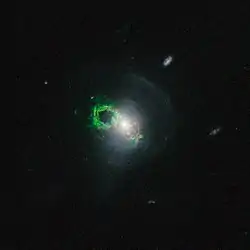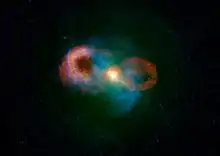Teacup galaxy
The Teacup galaxy,[3] also known as the Teacup AGN[2] or SDSS J1430+1339 is a low redshift type 2 quasar,[4] showing extended loop of ionized gas resembling a handle of a teacup, which was discovered by volunteers of the Galaxy Zoo project and labeled as a Voorwerpje.[5]
 | |
| The Teacup Galaxy as seen by the Hubble Space Telescope | |
| Credit: NASA, ESA, W. Keel (University of Alabama), and the Galaxy Zoo Team | |
| Observation data Epoch J2000.0 | |
|---|---|
| Constellation | Boötes[1] |
| Right ascension | 14h 30m 29.868s[2] |
| Declination | +13° 39′ 11.79″[2] |
| Apparent dimension (V) | 0.223' × 0.197'[2] |
| Astrometry | |
| Redshift | 0.08513[2] |
| Other designations | |
Galaxy
The Teacup galaxy is dominated by a bulge and has a asymmetric structure with a shell-like structure and a tidal tail. The shell and tail are signatures of a recent merger of two galaxies.[6] Dust lanes in the system are interpreted as a gas-rich merger.[7] Several candidate star clusters were identified in this galaxy with Hubble Space Telescope images.[6] Observations with the Gran Telescopio Canarias showed that the Teacup Galaxy has a giant reservoir of ionized gas extending up to 111 kpc. The optical/radio bubbles seem to be expanding across this intergalactic medium.[4]
Active galactic nucleus
Early studies of the Teacup AGN suggested that it is fading,[8] although there was no clear evidence.[9] Observations with VLT/SINFONI showed a blueshifted nuclear outflow with a velocity of 1600–1800 km/s.[10] Observations in x-rays with Swift, XMM-Newton and Chandra revealed a powerful, highly obscured active galactic nucleus. This new result suggests that the AGN might not require fading. The quasar has dimmed by only a factor of 25 or less over the past 100,000 years.[11][1]
Bubbles

One bubble was discovered by Galaxy Zoo volunteers in SDSS images as a 5 kpc loop of ionized gas.[5] The loop is dominated by emission lines, such as hydrogen alpha and doubly ionized oxygen, which gives the loop seen in SDSS images a purple color. The emission of [O II] is extremely strong in the Teacup AGN and the quasar 3C 48 shows a similar [O II]/Hβ ratio.[8]
Follow-up observations with the Very Large Array showed two 10-12 kpc bubbles, one "eastern bubble", consistent with the loop in optical observations and a "western bubble", only visible in radio wavelengths. The study also found a bright emission towards the north-east of the AGN, which is consistent with high-velocity ionized gas (-740 km/s). The bubbles are either created by small-scale radio jets or by quasar winds.[7]
Observations with Chandra revealed a loop in x-ray emission, consistent with the "eastern bubble". The Chandra data also show evidence for hotter gas within the bubble, which may imply that a wind of material is blowing away from the black hole. Such a wind, which was driven by radiation from the quasar, may have created the bubbles found in the Teacup.[11][1]
References
- "Chandra :: Photo Album :: SDSS J1430+1339 :: March 14, 2019". chandra.harvard.edu. Retrieved 2020-01-27.
- "Teacup AGN". SIMBAD. Centre de données astronomiques de Strasbourg. Retrieved 2020-01-27.
- [email protected]. "Hubble view of green filament in Teacup galaxy". www.spacetelescope.org. Retrieved 2020-01-27.
- Martin, Montserrat Villar; Lavers, Antonio Cabrera; Humphrey, Andrew; Silva, Marckelson; Almeida, Cristina Ramos; Piqueras, Javier; Emonts, Bjorn (2018-02-21). "A 100 kpc nebula associated with the "Teacup" fading quasar". Monthly Notices of the Royal Astronomical Society. 474 (2): 2302–2312. arXiv:1711.02529. doi:10.1093/mnras/stx2911. ISSN 0035-8711.
- Keel, William C.; Chojnowski, S. Drew; Bennert, Vardha N.; Schawinski, Kevin; Lintott, Chris J.; Lynn, Stuart; Pancoast, Anna; Harris, Chelsea; Nierenberg, A. M.; Sonnenfeld, Alessandro; Proctor, Richard (2012-02-11). "The Galaxy Zoo survey for giant AGN-ionized clouds: past and present black hole accretion events". Monthly Notices of the Royal Astronomical Society. 420 (1): 878–900. doi:10.1111/j.1365-2966.2011.20101.x. ISSN 0035-8711.
- Keel, William C.; Maksym, W. Peter; Bennert, Vardha N.; Lintott, Chris J.; Chojnowski, S. Drew; Moiseev, Alexei; Smirnova, Aleksandrina; Schawinski, Kevin; Urry, C. Megan; Evans, Daniel A.; Pancoast, Anna (2015-04-14). "HST Imaging of Fading AGN Candidates I: Host-Galaxy Properties and Origin of the Extended Gas". The Astronomical Journal. 149 (5): 155. arXiv:1408.5159. doi:10.1088/0004-6256/149/5/155. ISSN 1538-3881.
- Harrison, C. M.; Thomson, A. P.; Alexander, D. M.; Bauer, F. E.; Edge, A. C.; Hogan, M. T.; Mullaney, J. R.; Swinbank, A. M. (2015-02-06). "Storm in a "Teacup": a radio-quiet quasar with ~10kpc radio-emitting bubbles and extreme gas kinematics". The Astrophysical Journal. 800 (1): 45. arXiv:1410.4198. doi:10.1088/0004-637X/800/1/45. ISSN 1538-4357.
- Gagne, J. P.; Crenshaw, D. M.; Kraemer, S. B.; Schmitt, H. R.; Keel, W. C.; Rafter, S.; Fischer, T. C.; Bennert, V. N.; Schawinski, K. (2014-08-18). "Spatially-Resolved Spectra of the "Teacup" AGN: Tracing the History of a Dying Quasar". The Astrophysical Journal. 792 (1): 72. arXiv:1407.1729. doi:10.1088/0004-637X/792/1/72. ISSN 1538-4357.
- Keel, William C.; Lintott, Chris J.; Maksym, W. Peter; Bennert, Vardha N.; Chojnowski, S. Drew; Moiseev, Alexei; Smirnova, Aleksandrina; Schawinski, Kevin; Sartori, Lia F.; Urry, C. Megan; Pancoast, Anna (2017-02-01). "Fading AGN Candidates: AGN Histories and Outflow Signatures". The Astrophysical Journal. 835 (2): 256. arXiv:1612.06006. doi:10.3847/1538-4357/835/2/256. ISSN 1538-4357.
- Almeida, Cristina Ramos; López, Javier Piqueras; Villar-Martín, Montserrat; Bessiere, Patricia S. (2017-09-01). "An infrared view of AGN feedback in a type-2 quasar: the case of the Teacup galaxy". Monthly Notices of the Royal Astronomical Society. 470 (1): 964–976. arXiv:1705.07631. doi:10.1093/mnras/stx1287. ISSN 0035-8711.
- Lansbury, G. B.; Jarvis, M. E.; Harrison, C. M.; Alexander, D. M.; Del Moro, A.; Edge, A. C.; Mullaney, J. R.; Thomson, A. (2018-03-19). "Storm in a Teacup: X-ray view of an obscured quasar and superbubble". The Astrophysical Journal. 856 (1): L1. arXiv:1803.00009. doi:10.3847/2041-8213/aab357. ISSN 2041-8213.
External links
- Hubble spies the Teacup, and I spy Hubble blog post from the Galaxy Zoo website
- Voorwerpjes in Space NASA Astronomy Picture of the Day
- VLA Finds Unexpected Storm at Galaxy’s Core press-release by NRAO
- SDSS J1430+1339: Storm Rages in Cosmic Teacup photo album by the website of Chandra